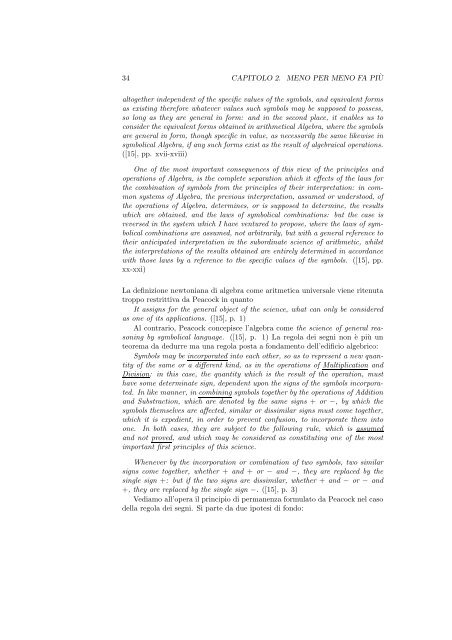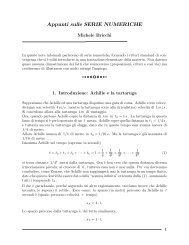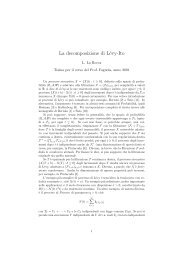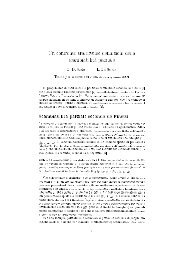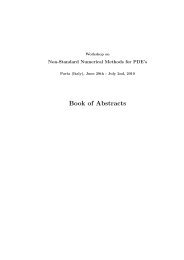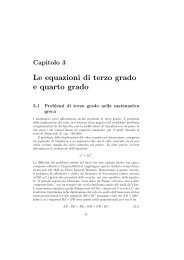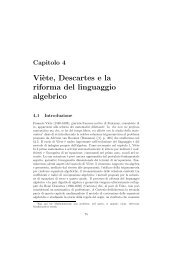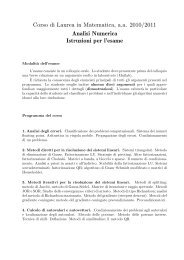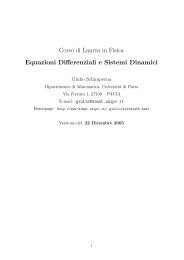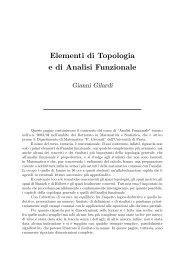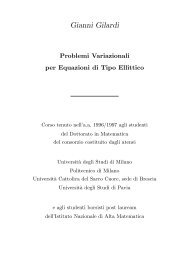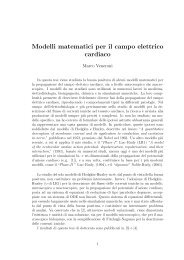Capitolo II - Dipartimento di Matematica
Capitolo II - Dipartimento di Matematica
Capitolo II - Dipartimento di Matematica
Create successful ePaper yourself
Turn your PDF publications into a flip-book with our unique Google optimized e-Paper software.
34 CAPITOLO 2. MENO PER MENO FA PIÙ<br />
altogether independent of the specific values of the symbols, and equivalent forms<br />
as existing therefore whatever values such symbols may be supposed to possess,<br />
so long as they are general in form: and in the second place, it enables us to<br />
consider the equivalent forms obtained in arithmetical Algebra, where the symbols<br />
are general in form, though specific in value, as necessarily the same likewise in<br />
symbolical Algebra, if any such forms exist as the result of algebraical operations.<br />
([15], pp. xvii-xviii)<br />
One of the most important consequences of this view of the principles and<br />
operations of Algebra, is the complete separation which it effects of the laws for<br />
the combination of symbols from the principles of their interpretation: in common<br />
systems of Algebra, the previous interpretation, assumed or understood, of<br />
the operations of Algebra, determines, or is supposed to determine, the results<br />
which are obtained, and the laws of symbolical combinations: but the case is<br />
reversed in the system which I have ventured to propose, where the laws of symbolical<br />
combinations are assumed, not arbitrarily, but with a general reference to<br />
their anticipated interpretation in the subor<strong>di</strong>nate science of arithmetic, whilst<br />
the interpretations of the results obtained are entirely determined in accordance<br />
with those laws by a reference to the specific values of the symbols. ([15], pp.<br />
xx-xxi)<br />
La definizione newtoniana <strong>di</strong> algebra come aritmetica universale viene ritenuta<br />
troppo restrittiva da Peacock in quanto<br />
It assigns for the general object of the science, what can only be considered<br />
as one of its applications. ([15], p. 1)<br />
Al contrario, Peacock concepisce l’algebra come the science of general reasoning<br />
by symbolical language. ([15], p. 1) La regola dei segni non è più un<br />
teorema da dedurre ma una regola posta a fondamento dell’e<strong>di</strong>ficio algebrico:<br />
Symbols may be incorporated into each other, so as to represent a new quantity<br />
of the same or a <strong>di</strong>fferent kind, as in the operations of Multiplication and<br />
Division: in this case, the quantity which is the result of the operation, must<br />
have some determinate sign, dependent upon the signs of the symbols incorporated.<br />
In like manner, in combining symbols together by the operations of Ad<strong>di</strong>tion<br />
and Substraction, which are denoted by the same signs + or −, by which the<br />
symbols themselves are affected, similar or <strong>di</strong>ssimilar signs must come together,<br />
which it is expe<strong>di</strong>ent, in order to prevent confusion, to incorporate them into<br />
one. In both cases, they are subject to the following rule, which is assumed<br />
and not proved, and which may be considered as constituting one of the most<br />
important first principles of this science.<br />
Whenever by the incorporation or combination of two symbols, two similar<br />
signs come together, whether + and + or − and −, they are replaced by the<br />
single sign +: but if the two signs are <strong>di</strong>ssimilar, whether + and − or − and<br />
+, they are replaced by the single sign −. ([15], p. 3)<br />
Ve<strong>di</strong>amo all’opera il principio <strong>di</strong> permanenza formulato da Peacock nel caso<br />
della regola dei segni. Si parte da due ipotesi <strong>di</strong> fondo:


